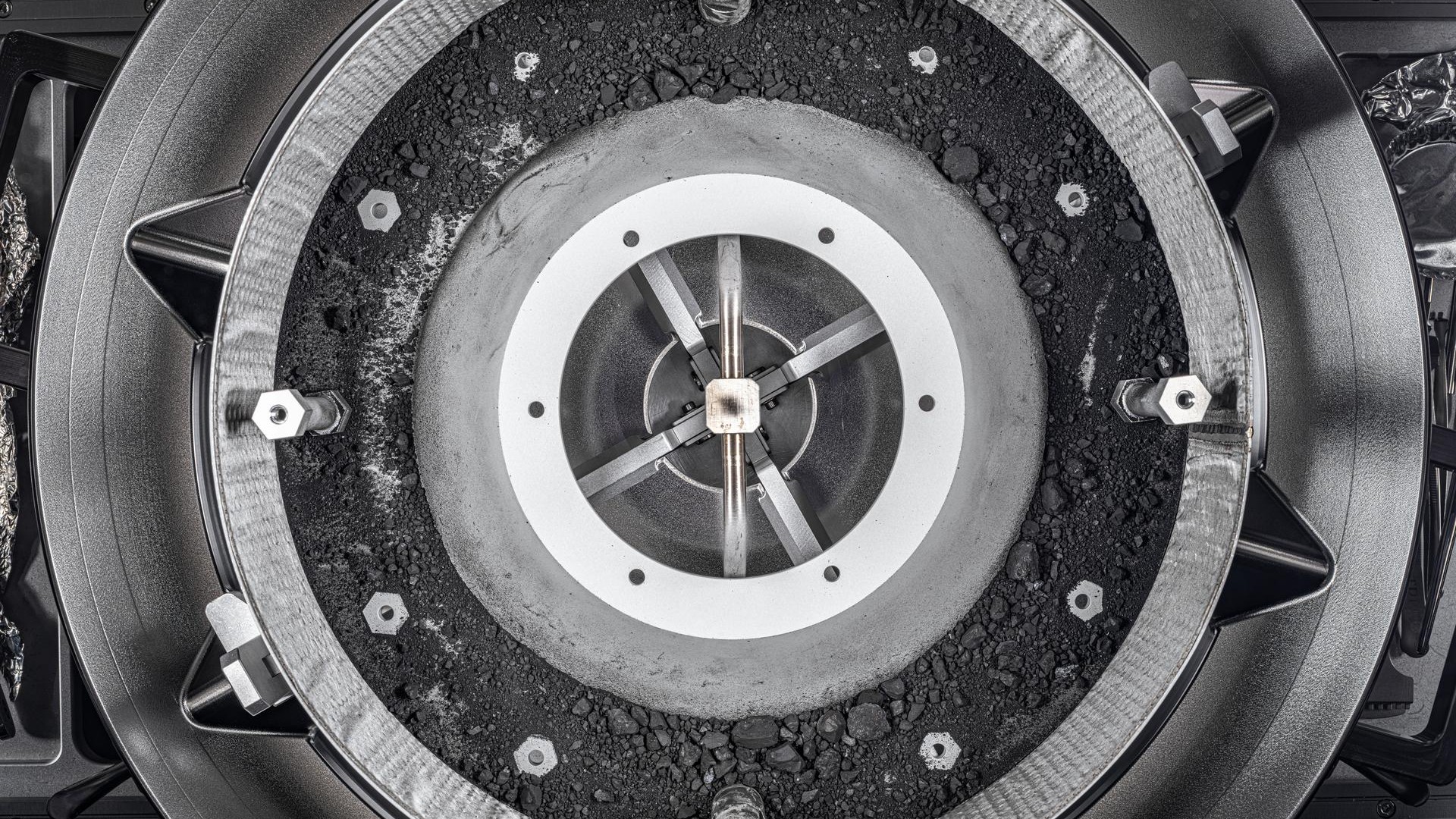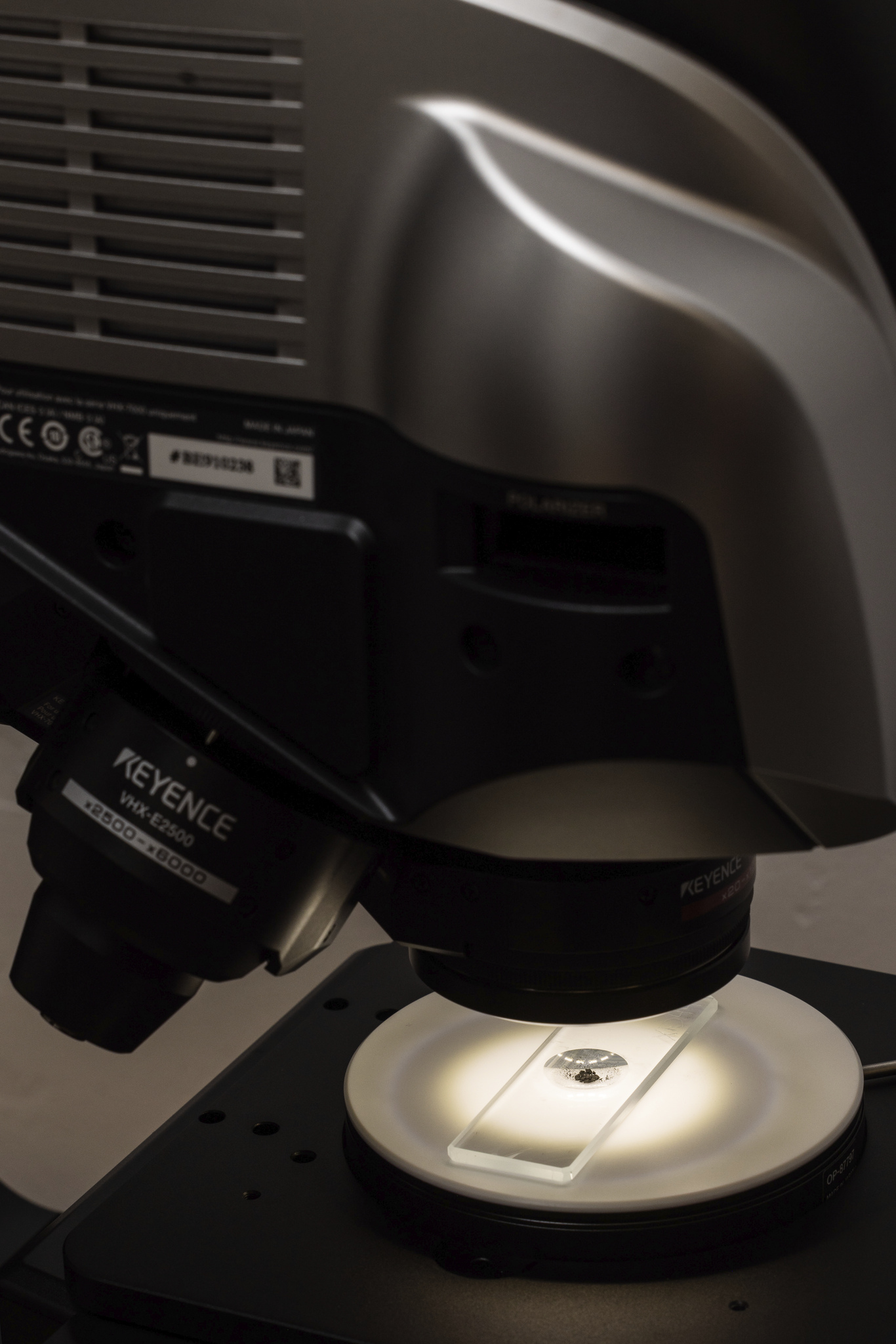1st look at asteroid Bennu samples suggests space rock may even be 'a fragment of an ancient ocean world'
'We're going to be busy for a long, long time. This is an enormous amount of sample for us.'

Scientists are now inspecting snagged, bagged and tagged bits and pieces from asteroid Bennu, the cosmic mother lode delivered by NASA's Origins, Spectral Interpretation, Resource Identification and Security — Regolith Explorer mission.
Known in acronymic astro-speak as OSIRIS-REx, that seven-year-long voyage brought home the goods via a sample return canister that came to full stop on Sept. 24, 2023, parachuting into a remote stretch of the Department of Defense's Utah Test and Training Range. Those specimens from afar are believed to contain the leftovers from the formation of the solar system 4.5 billion years ago.
Space.com caught up with two leading scientists now engaged in extracting what those darkish asteroid particles are illuminating, sorting out how these materials exported from Bennu came to be. But also what insights they hold for the origin of the worlds within our solar system, including Earth.
Related: NASA's 1st asteroid sample is rich in carbon and water, OSIRIS-REx team finds
Pristine reservoir
The scene is the University of Arizona's Kuiper-Arizona Laboratory for Astromaterials Analysis. Researchers there are using instruments to dig into what the OSIRIS-REx collectibles are telling them, right down to the atomic scale.
For a start, University of Arizona scientists received 200 milligrams — roughly seven-thousandths of an ounce — of the asteroid Bennu sample for analysis.
"We have over a 1,000 particles that are greater than half-a-millimeter, 28 particles that are greater than a centimeter, and the biggest particle is 3.5 centimeters," said University of Arizona's Dante Lauretta, the principal investigator for OSIRIS-REx. "So a great collection full of really large stones."
Breaking space news, the latest updates on rocket launches, skywatching events and more!
Bennu samples contain plentiful amounts of water locked up in minerals like clays and are also rich in carbon, nitrogen, sulfur, and phosphorous. OSIRIS-REx samples represent the largest pristine reservoir of such material on Earth.
"We're going to be busy for a long, long time," Lauretta told Space.com. "This is an enormous amount of sample for us," he said, with specimens of Bennu now also under study all over the globe.
Distinct and different
What's being found is to be detailed at next month's 55th Lunar and Planetary Science Conference held in The Woodlands, Texas. Over 70 abstracts of science output have been submitted to that prestigious meeting, Lauretta said. "Starting in March that's all going to be released out to the world. So the team is working furiously," he said.
One early finding is that the asteroid material under inspection looks "distinct and different than anything else in our meteorite collection isotopically, which is exciting," said Lauretta. "There's a whole realm of material that we never get access to if we just rely on meteorites," Lauretta added.
Most meteorites that endure their fiery fall through Earth's atmosphere and are recovered are bits of asteroids. But pinpointing the space rock from which they originated is not easily done.
Phosphate crust
OSIRIS-REx samples have a phosphate crust never seen before in meteorites, Lauretta said. These high concentrations of phosphate have been detected in extraterrestrial ocean worlds, he said.
For instance, Saturn's moon Enceladus contains phosphates, a key building block of life and at levels much higher than Earth's oceans.
"Asteroid Bennu may be a fragment of an ancient ocean world. That's still highly speculative. But it's the best lead I have right now to explain the origin of that material," Lauretta said.
Connect the dots
Unraveling the history of asteroid Bennu is a surreal undertaking, said Thomas Zega, a professor at the university's Lunar and Planetary Laboratory and scientific director at the school's Kuiper-Arizona Laboratory for Astromaterials Analysis.
Zega points to the decades that bookended the OSIRIS-REx mission, from a fleshed-out proposal to having the asteroid samples under extreme study in the laboratory.
"Honestly, seldom does a day go by where I don't consider myself incredibly fortunate to actually do this for a living," Zega told Space.com. "I pinch myself. It's a blessing."
By any definition the OSIRIS-REx mission has been a phenomenal success, Zega added, "and now being able to use some of the most sophisticated analytical tools on the planet to measure the samples, it's quite remarkable."
Missions like OSIRIS-REx, aside from teaching scientists about the origins of Bennu, Zega noted, "they really do help us connect the dots between other meteorites we have in our terrestrial collections," he said, "and perhaps the asteroids they come from in the asteroid belt between Mars and Jupiter."
Quick-look
Zega was a member of the "quick-look" team that took part in the opening of the OSIRIS-REx sample return capsule after delivery to NASA's Johnson Space Center in Houston, Texas.
What was found by curation team experts was a coating of fine-grained dust from the sampling maneuver at Bennu on the returned avionics deck and the outside of the Touch-and-Go Sample Acquisition Mechanism (TAGSAM) — the air filter-like contraption on the end of the OSIRIS-REx robot arm that snared the bulk of Bennu fragments.
One aspect of Zega's surreal encounter with Bennu is departing Texas and flying back to Arizona with a pre-arranged, small fraction of sample from the asteroid.
After all, Zega's express courier duties are due to the University of Arizona being home base for some 20 years of work to move OSIRIS-REx from bid to a ballistic entry of asteroid material.
Cover of darkness
"There was no way it was going in checked luggage! It went into my backpack that I carried onto the plane. It was a tiny amount of material, sealed in a bag which itself was sealed in a vial that had been filled with nitrogen. So it was all protected," Zega recalled.
Landing in Tucson at night, the first thing Zega did was to hustle the sample into a dry nitrogen box at the university lab for protection and preservation.
"And then I went home, had dinner, and went to sleep," Zega recounted.
Zega said he jokes that the whole thing was under the cover of darkness. "Nobody was the wiser that somebody had just brought the first sample from the first NASA asteroid sample return to Tucson," he said.
Stay tuned
Last month, on Jan. 10, the OSIRIS-REx TAGSAM head stuffed with Bennu bits was fully opened by NASA curators. That final step was slow in coming due to a couple of troublesome fasteners that thwarted an eyes-on look-see at the total cargo of asteroid collectibles.
Now on tap is releasing a catalog of all the Bennu samples later this year, giving scientists and institutions around the world the ability to submit requests for scrutinizing the spacecraft's bites of Bennu.
In the meantime, Lauretta and Zega, along with colleagues are busily appraising Bennu specimens.
Teams of university students and faculty are making use of a wide range of capabilities, from optical and electron microscopes to a newly acquired tool.
A powerful nanoSIMS instrument is up and running and is offering stunning looks at isotopes (different variations of atoms) to help interpret how each particular component in the Bennu sample originated.
"We've got lots of cool stuff happening over the next few months," Lauretta said. "So stay tuned."

Leonard David is an award-winning space journalist who has been reporting on space activities for more than 50 years. Currently writing as Space.com's Space Insider Columnist among his other projects, Leonard has authored numerous books on space exploration, Mars missions and more, with his latest being "Moon Rush: The New Space Race" published in 2019 by National Geographic. He also wrote "Mars: Our Future on the Red Planet" released in 2016 by National Geographic. Leonard has served as a correspondent for SpaceNews, Scientific American and Aerospace America for the AIAA. He has received many awards, including the first Ordway Award for Sustained Excellence in Spaceflight History in 2015 at the AAS Wernher von Braun Memorial Symposium. You can find out Leonard's latest project at his website and on Twitter.




